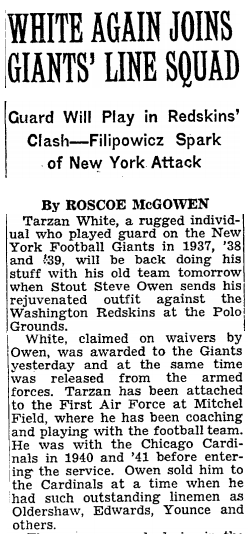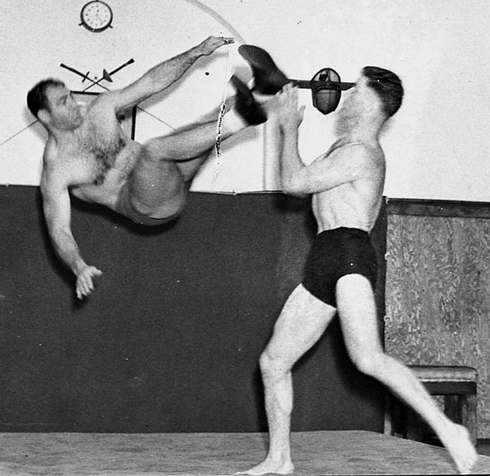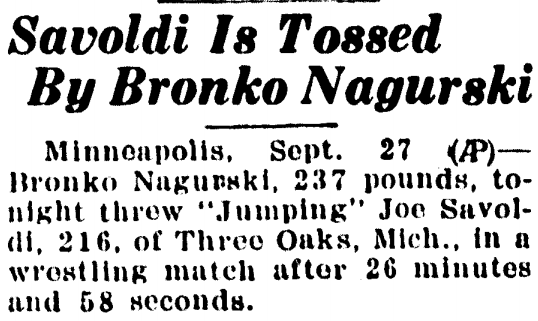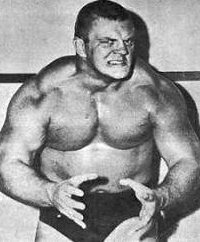Arthur “Tarzan” White was semi-famous even before he made his NFL debut with Giants in 1937. After all, not many players are nicknamed Tarzan — or have the personality White possessed. When his Alabama team went west to play in the Rose Bowl after the 1934 season, the Los Angeles Times couldn’t help writing about him, despite the fact he was just a “sub” on a line that had Don Hutson at one end and Bear Bryant at the other.
“Although only a sophomore of 19 years,” Braven Dyer’s story went,
”Tarzan” weighs 200 pounds despite his abbreviated stature of 5 feet, 7 inches. His real name is Arthur, which sounds harmless and in direct contrast to the “Tarzan” nickname. As a youngster White became tremendously interested in the so-called comic strip, by Edgar Rice Burroughs, featuring the exploits of the famous man of the jungle. So impressed was the Alabama youth by these pictures and yarns that he built himself a house in the trees. He actually practiced swinging through the trees . . . and is said to have been very proficient. White also practiced with the bow and arrow and achieved such perfection that he could go out and bring down wild game with these primitive weapons. Whether he ever wrestled with a lion or tried to ride an alligator bareback is something they neglected to tell me.
Speaking of Burroughs, he once tried to stop White and other wrestlers from appropriating Tarzan’s name, believing they lacked the virtue, athleticism and unspoiled innocence normally 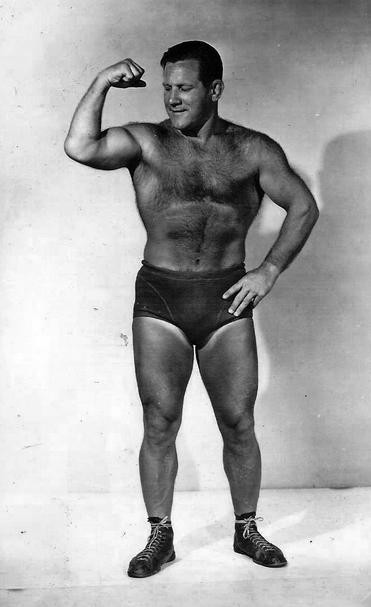 associated with his character. (What do you suppose gave him that idea?)
associated with his character. (What do you suppose gave him that idea?)
“The other self-christened Tarzans are apes, all right,” he told the United Press, “only they’re muscle-bound and have broken noses. Tarzan is a copyrighted trademark, and if these plug uglies insist on using it, I’m going to insist on the right to license them and stencil the copyright number on their chests.”
Naturally, the “self-christened Tarzans” ignored him.
Tonight’s bout, from the International Amphitheatre in Chicago, pits Tarzan against the aptly named Chest Bernard. (As broadcaster Russ Davis says, “This guy is called The Chest, and with justifiable reason. Hel-looooo!”) If Bernard was The Chest, then White could just as easily have been The Back. The fur on it was so thick it could have been mistaken for the the Real Tarzan’s native habitat.
“Tarzan White sits around the dressing room and plays solitaire by the hour,” Davis says. “[I] walked in tonight to see him before the bout. There he was, playing solitaire and whistling a tune. . . . And he never cheats with himself.”
No, Tarzan always played the good guy in the ring. Bernard was the villain, refusing to shake his hand at the outset and constantly pulling his hair and grabbing hold of his trunks. (Davis: “Mr. Bernard, sir, you are a stinker, sir.”)
Tarzan gave away 37 pounds in the match, weighing 225 to The Chest’s 262, which wasn’t unusual, apparently. According to Davis, he was “one of the smallest of the heavyweights.” He was naturally strong, though, and dead-lifted Bernard — in the days, mind you, before iron-pumping was in vogue — several times.
Wrestlingdata.com says Tarzan’s career spanned from 1939 to ’64. The following bout took place Jan. 25, 1952, when he was 36 and had been out of pro football for six years. He spent his first three seasons with the Giants, the next two with the Chicago Cardinals, then returned to the Giants in 1945 after a serving in the Air Force during World War II.
Tarzan was never busier in the ring, in fact, than in ’52, wrestling (at least) 75 times. His bout with The Chest was one fall with a 30-minute time limit. All set? Here we go . . .
Broadcaster Davis was right. “He’s a mean one, this Bernard.”
Sources: pro-football-reference.com, wrestlingdata.com.

